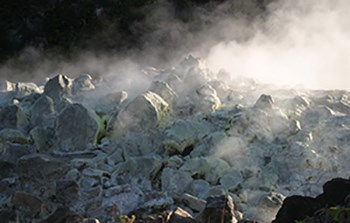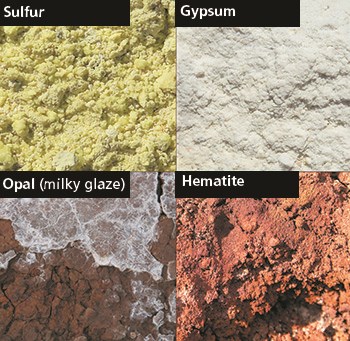

NPS Photo/D. Boyle At Wahinekapu (Steaming Bluff), you can feel hot water vapor as it billows from the ground in steam vents. This striking phenomenon is created as ground water seeps down to rocks heated by magma deep underground. The rocks are so hot that it vaporizes the water, returning it to the surface as steam. A short distance away, at Ha'akulamanu (Sulphur Banks), volcanic gases seep out of the ground, along with ground water steam. These fumes can be amazingly hot. In 1922, scientists drilled two holes to measure underground heat in the area. Temperature measurements remained constant at 205° F (96° C) down to 50 feet (15 m), the maximum depth drilled. Fumes emitted here include sulfur dioxide (SO2), which smells like a struck match, and hydrogen sulfide (H2S), the gas that smells like rotten eggs. These two gases react chemically to produce pure sulfur, a yellow mineral known to Hawaiians as kūkaepele, the waste of Pele. 
Minerals at Haʻakulamanu Why do some points release potentially dangerous volcanic gases, while others only exude mere water vapor? It all depends on the depth of the crack. Shallow earth cracks emit only steam, as they are not deep enough for volcanic gases to seep up. However, deep faults and fractures that extend down to magma allow gases a pathway to the surface, as at Ha'akulamanu. 
“The smell of sulfur is strong, but not unpleasant to a sinner.”—Mark Twain about the summit of Kīlauea, 1866
|
Last updated: June 22, 2022
